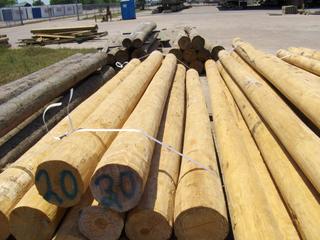This is the most comprehensive directory I have seen for the Forest Industry.
http://www.forestdirectory.com/
Sunday, July 31, 2005
Great Forestry Industry Site
Posted by
Chris Denny
at
10:40 PM
0
comments
![]()
Friday, July 29, 2005
8-25 Round Stock Inventory Grid
 This is the 825 Log Inventory Grid, a display of a method for coding and managing log and round stock inventories. The name is derived from the two dimensional differentiation of the inventory coding decision and should be read "eight, twenty-five."
This is the 825 Log Inventory Grid, a display of a method for coding and managing log and round stock inventories. The name is derived from the two dimensional differentiation of the inventory coding decision and should be read "eight, twenty-five."
Simply explained, any pole with dimensions of 8" TOP X 25' or smaller will be coded by TOP (blue) and anything with a 9" BUTT or larger OR longer than 25' will be coded by BUTT size (red). Certain dimensions might not need codes because of duplicities (e.g. - 9"BUTT x 10' = 8"TOP X 10').
The 825 model is based on the most often specified pole and piling sizes as well as general inventory control needs.
As with any method of pole and piling inventory, there are still conflicts between inventory mangement requirements and sales/customer requirements. Specifically, in order to maintain inventory quantity accuracy, the same item code or SKU should always be used regardless of customer specification. However, the sales system should have the capability to customize the DESCRIPTION of the pole or piling in order to (1) minimize questions in the mind of the customer and (2) ensure that the yard worker pulls the material the customer specifies. It is important that the yard worker who pulls the materials then offers feedback to the system (possibly via the salesperson), especially if a material subsitution was necessary.
If you have questions or comments about the 825 Log Inventory Method, please contact me at woodscience@gmail.com.
Posted by
Chris Denny
at
2:29 PM
0
comments
![]()
Thursday, July 28, 2005
Mill Production Output and Management
This pdf contains a great article regarding decision making in milling production from logs. It also contains an example of an overcomplication of simple concepts. Overall, the article is useful and touches on many of the factors milling managers need to take into account when making production decisions.
http://www.srs.fs.usda.gov/pubs/ja/ja_mendoza002.pdf
While there are many exceptional professionals in the lumber industry, the kind of material in this article should be displayed in a more easily understood format.
Posted by
Chris Denny
at
11:33 PM
1 comments
![]()
Southern Pine Beetles (SPBs)
These are some interesting pictures of SPB damage. The first is an arial photo of SPB damage to an area of forest in Louisiana. The second is a closeup of accute damage in a tree. 

Posted by
Chris Denny
at
8:00 PM
1 comments
![]()
Pole and Piling Inventory is the current issue
 Tracking inventories of poles and pilings is an industry-wide complication. The main issue is how to classify the poles/pilings because they are often requested or specified based on use. Pilings are typically requested/specified by BUTT size whereas poles are usually named by TOP size. This means the same piece of round stock might be requested in two different ways - for instance, a 10"BUTT 20' piling is the same as an 8" TOP 20' pole. This issue mainly causes confusion in TWO places - the inventory system and in the mind of the customer.
Tracking inventories of poles and pilings is an industry-wide complication. The main issue is how to classify the poles/pilings because they are often requested or specified based on use. Pilings are typically requested/specified by BUTT size whereas poles are usually named by TOP size. This means the same piece of round stock might be requested in two different ways - for instance, a 10"BUTT 20' piling is the same as an 8" TOP 20' pole. This issue mainly causes confusion in TWO places - the inventory system and in the mind of the customer.
A customer who is expecting a 10"BUTT 20' item might be confused by the 8" TOP description on an invoice. Notes can be made, etc, but it causes confusion nonetheless.
The simple solution of choosing one label method or the other and using a "special" line item to set the customer at ease often causes inaccuracies in the inventory tracking system. Let's use an example where we have decided to label the poles by TOP size but a customer has requested multiple pieces of a speficic BUTT size - 10"BUTT 20' for this example which would typically have an 8" TOP but might have a 7 1/2", or even 9", TOP. Because the yard worker is pulling materials based on the required BUTT size, he might actually be pulling poles of various TOP sizes, and thus different SKUs from inventory, whereas the salesperson only invoiced only 8" TOP SKUs.
This creates inaccuracies in inventory quantities and value as well as adversely affects the actual cost and margin of that specific sale.
Posted by
Chris Denny
at
6:17 PM
0
comments
![]()